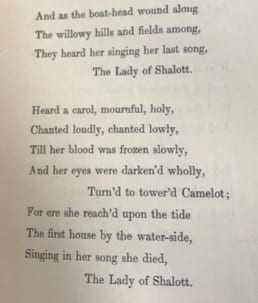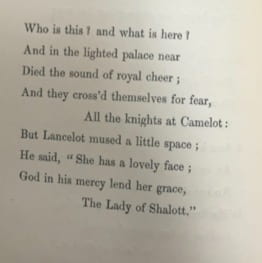Tennyson, Alfred. Poems. 1sted., Edward Moxon, 1833. ABLibrary Rare X 821.81 T312p 1833
Tennyson, Alfred. Poems. 1sted., Vol. 1, Edward Moxon, 1842. ABLibrary Rare X 821.81 M937p v.1
Rare Item Analysis: The Effects of Criticism: Tennyson’s “Lady of Shalott” after the “Ten Year’s Silence”
By Cristina Pierce
COVE timeline | COVE timeline entry | COVE map
Alfred Tennyson’s career as a poet did not begin very successfully. His first publication of Poems in 1832 received a negative review in The Quarterly Review; however, his second publication, which included his revisions of the same poems, was re-published in 1842 and was much more successful than the original. This gap of time, where Tennyson did not release any of his poetry and worked on these revisions, is known as the “Ten Year’s Silence.” The Armstrong Browning Library currently holds both original publications of the 1832 and 1842 editions of Poems in its Rare Books Collection. There are noticeable changes between these two editions, which are evidently influenced by Tennyson’s prolonged silence. One of the most significant changes is to the conclusion of “The Lady of Shalott.”
Tennyson’s “Ten Year’s Silence” is important to understand before delving into the differences between the separate editions of “The Lady of Shalott.” This period of time ranges from 1832 to 1842 and begins just after Tennyson’s original publication of the book of poetry. His silence results from two reasons: the death of Arthur Hallam and the criticism of his original publication in 1832. He met his beloved friend, Arthur Hallam, during his time at Trinity College in Cambridge, and together they pursued their careers in poetry. Hallam’s death in 1833 heavily impacted Tennyson’s life, ushering him into a depressed state. This depressed state was furthered by the problems that arose in his family, including his father’s alcoholism. Not only was he emotionally affected by the death of his friend and his family issues, but his writing was also stunted.
Tennyson was also greatly affected by the negative criticism of his publication of Poems in 1832. His son’s memoir describes his feelings about this original publication and how it was published prematurely. Before the criticism was released, Tennyson was already unsure of his own writing, and the critics only furthered his uncertainty about his writing (Green 662-666). The criticism that was probably the most effective was John Wilson Croker’s review in The Quarterly Review, which is also available in the Armstrong Browning Library. His harsh criticism directly attacks this prematurity in Tennyson’s poems, and he opens his review by stating that he will “seize this opportunity of repairing an unintentional neglect,” suggesting that Tennyson did not take the time to edit his writing (Croker). In the 1835 London Review, John Stuart Mill also harshly criticizes the 1832 edition of Poems, specifically the abrupt conclusion of “The Lady of Shalott.”
The conclusion of the 1832 version of “The Lady of Shalott” includes the deceased Lady floating down the river into Camelot with a parchment on her body. Mill writes that this ending is a “lame and impotent conclusion,” where no conclusion was wanted (Mill 413).
The parchment that lay on her dead body explains her curse and removes all mysteriousness of her character for the citizens of Camelot. This mysteriousness is vital to the intrigue of her overall character not only for the citizens of Camelot who discover her dead body, but also for readers. Her death scene in this conclusion also begins with the word “death,” and this word is repeated after she passes away. This repetition also takes away from the mysteriousness of the Lady of Shalott by explicitly telling readers that her curse is real and was unavoidable. By announcing her death in the beginning of the conclusion, the following details of how she slowly passes away lose their value. The 1832 version of “The Lady of Shalott” gives the Lady an undeserving death.
The 1842 version of “The Lady of Shalott” has a drastically different conclusion. Tennyson’s revision of this poem reveals his changes throughout his poem, but he paid close attention to this conclusion, showing that he listened to critics like Mill. This new ending is more deserving because it retains the mysteriousness of the Lady of Shalott’s character: it does not have the parchment that explains her curse and identity. Instead, the citizens of Camelot are given no information but her name, and only readers have knowledge of her curse. In addition, the conclusion no longer introduces the death scene with the word “death,” making the details of how she dies more impactful and shocking to readers. When her death is explicitly stated at the end of the scene, the reactions of the citizens of Camelot that follow hold more emotional value. Tennyson’s revision of this poem pays close attention to such details, and his hidden message to critics takes another route.
Both editions of the poem have a hidden message to the critics in the conclusion, but they are not the same. The Lady of Shalott has been understood as a figure for the isolated artist, representing the ideas and inspirations of the poet thathas been secluded and living safely and isolated in the tower. However, these ideas and inspirations die by the time they reach the citizens of Camelot, who stand in for the poet’s public and critics. The different reactions of these citizens in the conclusion are Tennyson’s assumptions of how the critics will react to his extraordinary poetry. In the 1832 version, the citizens of Camelot are “puzzled” by the Lady of Shalott’s death, which shows how Tennyson knows that his poetry is not as typical and conservative as the poetry that the critics, or “wellfed wits,” are used to reviewing. Though the 1842 version has the same confused reactions from the citizens with “Who is this? and what is here?,” it does not include the reference to critics as “wellfed wits.” Instead, Tennyson replaces it with an explanation of why anyone (the reading public and critics both) might react to the Lady and obscure poetry with confusion and alarm: “fear.” This movement from confusion to fear avoids singling out critics for ridicule (and thus perhaps avoids further reprisals) and instead suggests that everyone may be fearful of change in the world of poetry.
Alfred Tennyson’s “Ten Year’s Silence” changed his entire career as a poet. Not only was he more emotionally driven from Arthur Hallam’s death, but he also paid closer attention to the details in his poetry. The differences between the 1832 and 1842 versions of “The Lady of Shalott” demonstrate his maturity as a poet. His revision of this poem’s conclusion shows that he listened to the harsh criticism that he received in his original publications. This raises questions about the frequency of change in Tennyson’s style of writing between each of his book publications throughout his career. Did he continue to listen to critics after his 1842 publication of Poems, or was the “Ten Year’s Silence” his only period of change?
Works Cited
Croker, John Wilson. The Quarterly Review. Vol. 49, John Murray, 1833. The Quarterly Review, 6 June 2011, www.quarterly-review.org/poems-by-alfred-tennyson-review-from-spring-1833/.
Green, Joyce. “Tennyson’s Development during the ‘Ten Years’ Silence’ (1832-1842).” PMLA, vol. 66, no. 5, 1951, pp. 662–697. JSTOR, www.jstor.org/stable/459530.
“Tennyson’s Poems.”The London Review, vol. 1, no. 2,402-424, 1835. Retrieved from http://ezproxy.baylor.edu/login?url=https://search.proquest.com/docview/4347503?accountid=7014

Fig. 1. “The Lady of Shalott” (1842) 141-153

Fig. 2. “The Lady of Shalott” (1842) 163-171
